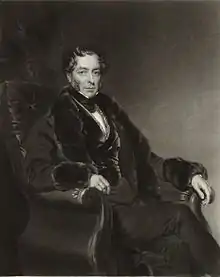Lord Byron
George Gordon Byron, 6th Baron Byron, FRS (22 January 1788 – 19 April 1824), known simply as Lord Byron, was an English peer, who was a poet and politician.[1][2] He was one of the leading figures of the Romantic movement[3][4][5] and is regarded as one of the greatest English poets.[6] He remains widely read and influential. Among his best-known works are the lengthy narrative poems Don Juan and Childe Harold's Pilgrimage; many of his shorter lyrics in Hebrew Melodies also became popular.
The Lord Byron | |
|---|---|
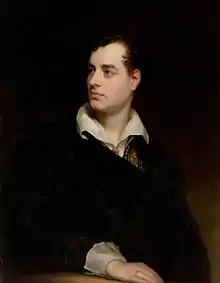 Portrait of Byron by Thomas Phillips, c. 1813 | |
| Member of the House of Lords Lord Temporal | |
| In office 13 March 1809 – 19 April 1824 Hereditary peerage | |
| Preceded by | The 5th Baron Byron |
| Succeeded by | The 7th Baron Byron |
| Personal details | |
| Born | George Gordon Byron 22 January 1788 London, England |
| Died | 19 April 1824 (aged 36) Missolonghi, Aetolia, Ottoman Empire (present-day Aetolia-Acarnania, Greece) |
| Cause of death | Fever |
| Resting place | Church of St. Mary Magdalene, Hucknall, Nottinghamshire |
| Nationality | British |
| Spouse(s) | |
| Domestic partner | Claire Clairmont |
| Children |
|
| Parents |
|
| Relatives | Vice-Admiral The Hon. John Byron (grandfather) |
| Education | Harrow School (1801–1805) |
| Alma mater | Trinity College, Cambridge (1805–1808) |
| Occupation | Poet, politician |
| Signature | |
He travelled extensively across Europe, especially in Italy, where he lived for seven years in the cities of Venice, Ravenna, and Pisa. During his stay in Italy he frequently visited his friend and fellow poet Percy Bysshe Shelley.[7] Later in life Byron joined the Greek War of Independence fighting the Ottoman Empire and died of disease leading a campaign during that war, for which Greeks revere him as a national hero.[8] He died in 1824 at the age of 36 from a fever contracted after the First and Second Siege of Missolonghi.
His only marital child, Ada Lovelace, is regarded as a foundational figure in the field of computer programming based on her notes for Charles Babbage's Analytical Engine.[9][10][11] Byron's extramarital children include Allegra Byron, who died in childhood, and possibly Elizabeth Medora Leigh, daughter of his half-sister Augusta Leigh.
Family and early life
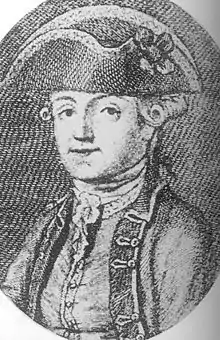
George Gordon Byron was born on 22 January 1788, on Holles Street in London – his birthplace is now supposedly occupied by a branch of the department store John Lewis.
Byron was the only child of Captain John Byron (known as 'Jack') and his second wife Catherine Gordon, heiress of the Gight estate in Aberdeenshire, Scotland. Byron's paternal grandparents were Vice-Admiral John Byron and Sophia Trevanion.[12] Having survived a shipwreck as a teenage midshipman, Vice Admiral John Byron set a new speed record for circumnavigating the globe. After he became embroiled in a tempestuous voyage during the American Revolutionary War, John was nicknamed 'Foul-Weather Jack' Byron by the press.[13]
Byron's father had previously been somewhat scandalously married to Amelia, Marchioness of Carmarthen, with whom he had been having an affair – the wedding took place just weeks after her divorce from her husband, and she was around eight months pregnant.[14] The marriage was not a happy one, and their first two children – Sophia Georgina, and an unnamed boy – died in infancy.[15] Amelia herself died in 1784 almost exactly a year after the birth of their third child, the poet's half-sister Augusta Mary.[16] Though Amelia succumbed to a wasting illness, probably tuberculosis, the press reported that her heart had been broken out of remorse for leaving her husband. Much later, 19th-century sources blamed Jack's own "brutal and vicious" treatment of her.[17]
Jack then married Catherine Gordon of Gight on 13 May 1785, by all accounts only for her fortune.[18] To claim his second wife's estate in Scotland, Byron's father took the additional surname "Gordon", becoming "John Byron Gordon", and occasionally styled himself "John Byron Gordon of Gight". Byron's mother had to sell her land and title to pay her new husband's debts, and in the space of two years, the large estate, worth some £23,500, had been squandered, leaving the former heiress with an annual income in trust of only £150.[17] In a move to avoid his creditors, Catherine accompanied her profligate husband to France in 1786, but returned to England at the end of 1787 to give birth to her son.
The boy was born on 22 January in lodgings at Holles Street in London, and christened at St Marylebone Parish Church as "George Gordon Byron". His father appears to have wished to call his son 'William', but as her husband remained absent, his mother named him after her own father George Gordon of Gight.[19] (His grandfather was a descendant of James I of Scotland, and died by suicide in 1779.)[20]
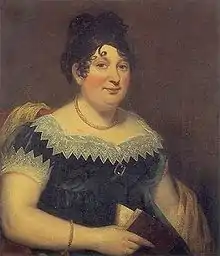
Catherine moved back to Aberdeenshire in 1790, where Byron spent his childhood.[20] His father soon joined them in their lodgings in Queen Street, but the couple quickly separated. Catherine regularly experienced mood swings and bouts of melancholy,[20] which could be partly explained by her husband's continuingly borrowing money from her. As a result, she fell even further into debt to support his demands. It was one of these importunate loans that allowed him to travel to Valenciennes, France, where he died of a "long & suffering illness" – probably tuberculosis – in 1791.[21]
When Byron's great-uncle, who was posthumously labelled the "wicked" Lord Byron, died on 21 May 1798, the 10-year-old boy became the sixth Baron Byron of Rochdale and inherited the ancestral home, Newstead Abbey, in Nottinghamshire. His mother proudly took him to England, but the Abbey was in an embarrassing state of disrepair and, rather than living there, she decided to lease it to Lord Grey de Ruthyn, among others, during Byron's adolescence.
Described as "a woman without judgment or self-command," Catherine either spoiled and indulged her son or vexed him with her capricious stubbornness. Her drinking disgusted him and he often mocked her for being short and corpulent, which made it difficult for her to catch him to discipline him. Byron had been born with a deformed right foot; his mother once retaliated and, in a fit of temper, referred to him as "a lame brat."[22] However, Byron's biographer, Doris Langley-Moore, in her 1974 book, Accounts Rendered, paints a more sympathetic view of Mrs Byron, showing how she was a staunch supporter of her son and sacrificed her own precarious finances to keep him in luxury at Harrow and Cambridge. Langley-Moore questions 19th-century biographer John Galt's claim that she over-indulged in alcohol.
Upon the death of Byron's mother-in-law Judith Noel, the Hon. Lady Milbanke, in 1822, her will required that he change his surname to "Noel" so as to inherit half of her estate. He obtained a Royal Warrant, allowing him to "take and use the surname of Noel only" and to "subscribe the said surname of Noel before all titles of honour". From that point he signed himself "Noel Byron" (the usual signature of a peer being merely the peerage, in this case simply "Byron"). It is speculated that this was so that his initials would read "N.B.", mimicking those of his hero, Napoleon Bonaparte. Lady Byron eventually succeeded to the Barony of Wentworth, becoming "Lady Wentworth".
Education
Byron received his early formal education at Aberdeen Grammar School, and in August 1799 entered the school of Dr. William Glennie, in Dulwich.[23] Placed under the care of a Dr. Bailey, he was encouraged to exercise in moderation but could not restrain himself from "violent" bouts in an attempt to overcompensate for his deformed foot. His mother interfered with his studies, often withdrawing him from school, with the result that he lacked discipline and his classical studies were neglected.
In 1801, he was sent to Harrow, where he remained until July 1805.[20] An undistinguished student and an unskilled cricketer, he did represent the school during the very first Eton v Harrow cricket match at Lord's in 1805.[24]
His lack of moderation was not restricted to physical exercise. Byron fell in love with Mary Chaworth, whom he met while at school,[20] and she was the reason he refused to return to Harrow in September 1803. His mother wrote, "He has no indisposition that I know of but love, desperate love, the worst of all maladies in my opinion. In short, the boy is distractedly in love with Miss Chaworth."[20] In Byron's later memoirs, "Mary Chaworth is portrayed as the first object of his adult sexual feelings."[25]
Byron finally returned in January 1804,[20] to a more settled period which saw the formation of a circle of emotional involvements with other Harrow boys, which he recalled with great vividness: "My school friendships were with me passions (for I was always violent)".[26] The most enduring of those was with John FitzGibbon, 2nd Earl of Clare—four years Byron's junior—whom he was to meet unexpectedly many years later in Italy (1821).[27] His nostalgic poems about his Harrow friendships, Childish Recollections (1806), express a prescient "consciousness of sexual differences that may in the end make England untenable to him."[28] Letters to Byron in the John Murray archive contain evidence of a previously unremarked if short-lived romantic relationship with a younger boy at Harrow, John Thomas Claridge.[29]
The following autumn, he went up to Trinity College, Cambridge,[30] where he met and formed a close friendship with the younger John Edleston. About his "protégé" he wrote, "He has been my almost constant associate since October, 1805, when I entered Trinity College. His voice first attracted my attention, his countenance fixed it, and his manners attached me to him for ever." Byron composed Thyrza, a series of elegies, in his memory.[31] In later years, he described the affair as "a violent, though pure love and passion". This statement, however, needs to be read in the context of hardening public attitudes toward homosexuality in England and the severe sanctions (including public hanging) against convicted or even suspected offenders.[32] The liaison, on the other hand, may well have been "pure" out of respect for Edleston's innocence, in contrast to the (probably) more sexually overt relations experienced at Harrow School.[33] The poem "The Cornelian" was written about the cornelian that Byron received from Edleston.[34]
Byron spent three years at Trinity College, engaging in sexual escapades, boxing, horse riding and gambling. While at Cambridge, he also formed lifelong friendships with men such as John Cam Hobhouse, who initiated him into the Cambridge Whig Club, which endorsed liberal politics, and Francis Hodgson, a Fellow at King's College, with whom he corresponded on literary and other matters until the end of his life.[35]
Career
Early career

While not at school or college, Byron dwelt at his mother's residence Burgage Manor in Southwell, Nottinghamshire.[20] While there, he cultivated friendships with Elizabeth Bridget Pigot and her brother, John, with whom he staged two plays for the entertainment of the community. During this time, with the help of Elizabeth Pigot, who copied many of his rough drafts, he was encouraged to write his first volumes of poetry. Fugitive Pieces was printed by Ridge of Newark, which contained poems written when Byron was only 17.[36] However, it was promptly recalled and burned on the advice of his friend, the Reverend J. T. Becher, on account of its more amorous verses, particularly the poem To Mary.[37]
Hours of Idleness, which collected many of the previous poems, along with more recent compositions, was the culminating book. The savage, anonymous criticism this received (now known to be the work of Henry Peter Brougham) in the Edinburgh Review prompted his first major satire,[38] English Bards and Scotch Reviewers (1809). It was put into the hands of his relation, R. C. Dallas, requesting him to "...get it published without his name."[39] Alexander Dallas gave a large series of changes and alterations, as well as the reasoning for some of them. He also stated that Byron had originally intended to prefix an argument to this poem, and Dallas quoted it.[40] Although the work was published anonymously, by April, R. C. Dallas wrote that "you are already pretty generally known to be the author".[41] The work so upset some of his critics they challenged Byron to a duel; over time, in subsequent editions, it became a mark of prestige to be the target of Byron's pen.[38]

After his return from travels he again entrusted R. C. Dallas as his literary agent to publish his poem Childe Harold's Pilgrimage, which Byron thought of little account. The first two cantos of Childe Harold's Pilgrimage were published in 1812 and were received with acclaim.[42][43] In his own words, "I awoke one morning and found myself famous."[44] He followed up his success with the poem's last two cantos, as well as four equally celebrated "Oriental Tales": The Giaour, The Bride of Abydos, The Corsair, and Lara. About the same time, he began his intimacy with his future biographer, Thomas Moore.
First travels to the East

Byron racked up numerous debts as a young man, owing to what his mother termed a "reckless disregard for money".[20] She lived at Newstead during this time, in fear of her son's creditors.[20] He had planned to spend early 1808 cruising with his cousin, George Bettesworth, who was captain of the 32-gun frigate HMS Tartar. Bettesworth's death at the Battle of Alvøen in May 1808 made that impossible.
From 1809 to 1811,[45] Byron went on the Grand Tour, then customary for a young nobleman. He travelled with Hobhouse for the first year and his entourage of servants included Byron's trustworthy valet, William Fletcher. Fletcher was often the butt of Hobhouse and Byron’s humour. The Napoleonic Wars forced him to avoid most of Europe, and he instead turned to the Mediterranean. The journey provided the opportunity to flee creditors, as well as a former love, Mary Chaworth (the subject of his poem from this time, "To a Lady: On Being Asked My Reason for Quitting England in the Spring").[38] Letters to Byron from his friend Charles Skinner Matthews reveal that a key motive was also the hope of homosexual experience.[46] Attraction to the Levant was probably also a reason; he had read about the Ottoman and Persian lands as a child, was attracted to Islam (especially Sufi mysticism), and later wrote, "With these countries, and events connected with them, all my really poetical feelings begin and end."[47][48]
Byron began his trip in Portugal from where he wrote a letter to his friend Mr Hodgson in which he describes his mastery of the Portuguese language, consisting mainly of swearing and insults. Byron particularly enjoyed his stay in Sintra that is described in Childe Harold's Pilgrimage as "glorious Eden". From Lisbon he travelled overland to Seville, Jerez de la Frontera, Cádiz, and Gibraltar, and from there by sea on to Sardinia, Malta, and Greece.[49]
While in Athens, Byron met 14-year-old Nicolo Giraud, with whom he became quite close and who taught him Italian. It has been suggested that the two had an intimate relationship involving a sexual affair.[50] Byron sent Giraud to school at a monastery in Malta and bequeathed him the sizeable sum of £7,000. The will, however, was later cancelled.[51] "I am tired of pl & opt Cs, the last thing I could be tired of", Byron wrote to Hobhouse from Athens (an abbreviation of "coitum plenum et optabilem" – complete intercourse to one's heart's desire, from Petronius' Satyricon), which, as an earlier letter establishes, was their shared code for homosexual experience.[52]
In 1810 in Athens, Byron wrote "Maid of Athens, ere we part" for a 12-year-old girl, Teresa Makri (1798–1875).
Byron and Hobhouse made their way to Smyrna, where they cadged a ride to Constantinople on HMS Salsette. While Salsette was anchored awaiting Ottoman permission to dock at the city, on 3 May 1810 Byron and Lieutenant Ekenhead, of Salsette's Marines, swam the Hellespont. Byron commemorated this feat in the second canto of Don Juan. He returned to England from Malta in July 1811 aboard HMS Volage.[53]
England 1811–1816
.jpg.webp)
Byron became a celebrity with the publication of the first two cantos of Childe Harold's Pilgrimage (1812). "He rapidly became the most brilliant star in the dazzling world of Regency London. He was sought after at every society venue, elected to several exclusive clubs, and frequented the most fashionable London drawing-rooms."[23] During this period in England he produced many works, including The Giaour, The Bride of Abydos (1813), Parisina, and The Siege of Corinth (1815). On the initiative of the composer Isaac Nathan, he produced in 1814–1815 the Hebrew Melodies (including what became some of his best-known lyrics, such as "She Walks in Beauty" and "The Destruction of Sennacherib"). Involved at first in an affair with Lady Caroline Lamb (who called him "mad, bad and dangerous to know") and with other lovers and also pressed by debt, he began to seek a suitable marriage, considering – amongst others – Annabella Millbanke.[54] However, in 1813 he met for the first time in four years his half-sister, Augusta Leigh. Rumours of incest surrounded the pair; Augusta's daughter Medora (b. 1814) was suspected to have been Byron's. To escape from growing debts and rumours, Byron pressed his determination to marry Annabella, who was said to be the likely heiress of a rich uncle. They married on 2 January 1815, and their daughter, Ada, was born in December of that year. However, Byron's continuing obsession with Augusta (and his continuing sexual escapades with actresses such as Charlotte Mardyn[55][56] and others) made their marital life a misery. Annabella considered Byron insane, and in January 1816 she left him, taking their daughter, and began proceedings for a legal separation. Their separation was made legal in a private settlement in March 1816. The scandal of the separation, the rumours about Augusta, and ever-increasing debts forced him to leave England in April 1816, never to return.[23]
Life abroad (1816–1824)
The Shelleys
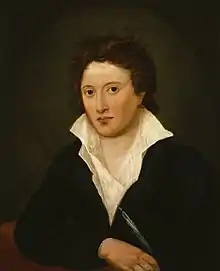 Percy Bysshe Shelley, 1819
Percy Bysshe Shelley, 1819 Mary Shelley, 1840
Mary Shelley, 1840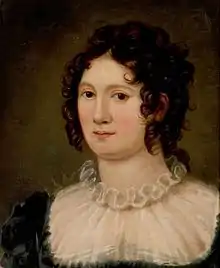
After this break-up of his domestic life, Byron left England and never returned. (Despite his dying wishes, however, his body was returned for burial in England.) He journeyed through Belgium and continued up the Rhine river. In the summer of 1816 he settled at the Villa Diodati by Lake Geneva, Switzerland, with his personal physician, John William Polidori. There Byron befriended the poet Percy Bysshe Shelley and Shelley's future wife, Mary Godwin. He was also joined by Mary's stepsister, Claire Clairmont, with whom he had had an affair in London.[57] Several times Byron went to see Germaine de Staël and her Coppet group, which turned out to be a valid intellectual and emotional support to Byron at the time.[58]

Kept indoors at the Villa Diodati by the "incessant rain" of "that wet, ungenial summer" over three days in June, the five turned to reading fantastical stories, including Fantasmagoriana, and then devising their own tales. Mary Shelley produced what would become Frankenstein, or The Modern Prometheus, and Polidori produced The Vampyre,[59] the progenitor of the Romantic vampire genre.[60][61] The Vampyre was the inspiration for a fragmentary story of Byron's, "A Fragment".[62]
Byron's story fragment was published as a postscript to Mazeppa; he also wrote the third canto of Childe Harold.
Byron wintered in Venice, pausing his travels when he fell in love with Marianna Segati, in whose Venice house he was lodging, and who was soon replaced by 22-year-old Margarita Cogni; both women were married. Cogni could not read or write, and she left her husband to move into Byron's Venice house. Their fighting often caused Byron to spend the night in his gondola; when he asked her to leave the house, she threw herself into the Venetian canal.[63]
Italy
.jpg.webp)
In 1816, Byron visited San Lazzaro degli Armeni in Venice, where he acquainted himself with Armenian culture with the help of the monks belonging to the Mechitarist Order. With the help of Father Pascal Aucher (Harutiun Avkerian), he learned the Armenian language[63] and attended many seminars about language and history. He co-authored Grammar English and Armenian in 1817, an English textbook written by Aucher and corrected by Byron, and A Grammar Armenian and English in 1819, a project he initiated of a grammar of Classical Armenian for English speakers, where he included quotations from classical and modern Armenian.[63]
Byron later participated in the compilation of the English Armenian dictionary (Barraran angleren yev hayeren, 1821) and wrote the preface, in which he explained Armenian oppression by the Turkish pashas and the Persian satraps and the Armenian struggle of liberation. His two main translations are the Epistle of Paul to the Corinthians, two chapters of Movses Khorenatsi's History of Armenia, and sections of Nerses of Lambron's Orations.[64]
His fascination was so great that he even considered a replacement of the Cain story of the Bible with that of the legend of Armenian patriarch Haik. He may be credited with the birth of Armenology and its propagation. His profound lyricism and ideological courage has inspired many Armenian poets, the likes of Ghevond Alishan, Smbat Shahaziz, Hovhannes Tumanyan, Ruben Vorberian, and others.[64]
In 1817, he journeyed to Rome. On returning to Venice, he wrote the fourth canto of Childe Harold. About the same time, he sold Newstead and published Manfred, Cain, and The Deformed Transformed. The first five cantos of Don Juan were written between 1818 and 1820. During this period he met the 18-year-old Countess Guiccioli, who found her first love in Byron, and asked her to elope with him.[63]
Led by love for the local aristocratic, young, and newly married Teresa Guiccioli, Byron lived in Ravenna from 1819 to 1821. Here he continued Don Juan and wrote the Ravenna Diary and My Dictionary and Recollections. Around this time he received visits from Percy Bysshe Shelley, as well as from Thomas Moore, to whom he confided his autobiography or "life and adventures", which Moore, Hobhouse, and Byron's publisher, John Murray,[63] burned in 1824, a month after Byron's death.[42] Of Byron's lifestyle in Ravenna we know more from Shelley, who documented some of its more colourful aspects in a letter: "Lord Byron gets up at two. I get up, quite contrary to my usual custom … at 12. After breakfast we sit talking till six. From six to eight we gallop through the pine forest which divide Ravenna from the sea; we then come home and dine, and sit up gossiping till six in the morning. I don’t suppose this will kill me in a week or fortnight, but I shall not try it longer. Lord B.'s establishment consists, besides servants, of ten horses, eight enormous dogs, three monkeys, five cats, an eagle, a crow, and a falcon; and all these, except the horses, walk about the house, which every now and then resounds with their unarbitrated quarrels, as if they were the masters of it… . [P.S.] I find that my enumeration of the animals in this Circean Palace was defective … . I have just met on the grand staircase five peacocks, two guinea hens, and an Egyptian crane. I wonder who all these animals were before they were changed into these shapes."[65]

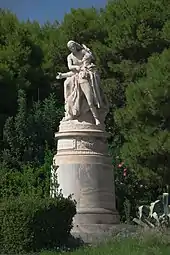
In 1821 Byron left Ravenna and went to live in the Tuscan city of Pisa, to which Teresa had also relocated. From 1821 to 1822, Byron finished Cantos 6–12 of Don Juan at Pisa, and in the same year he joined with Leigh Hunt and Shelley in starting a short-lived newspaper, The Liberal, in whose first number The Vision of Judgment appeared. For the first time since his arrival in Italy, Byron found himself tempted to give dinner parties; his guests included the Shelleys, Edward Ellerker Williams, Thomas Medwin, John Taaffe, and Edward John Trelawny; and "never", as Shelley said, "did he display himself to more advantage than on these occasions; being at once polite and cordial, full of social hilarity and the most perfect good humour; never diverging into ungraceful merriment, and yet keeping up the spirit of liveliness throughout the evening."[66]
Shelley and Williams rented a house on the coast and had a schooner built. Byron decided to have his own yacht, and engaged Trelawny's friend, Captain Daniel Roberts, to design and construct the boat. Named the Bolivar, it was later sold to Charles John Gardiner, 1st Earl of Blessington, and Marguerite, Countess of Blessington, when Byron left for Greece in 1823.[67][68]
Byron attended the funeral of Shelley, which was orchestrated by Trelawny after Williams and Shelley drowned in a boating accident on 8 July 1822. His last Italian home was Genoa. While living there he was accompanied by the Countess Guiccioli and the Blessingtons. Lady Blessington based much of the material in her book, Conversations with Lord Byron, on the time spent together there. This book became an important biographical text about Byron’s life just prior to his death.
Greece
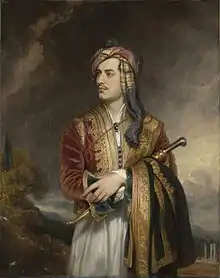
Byron was living in Genoa when, in 1823, while growing bored with his life there, he accepted overtures for his support from representatives of the movement for Greek independence from the Ottoman Empire.[69] At first, Byron did not wish to leave his 22-year-old mistress, Countess Teresa Guiccioli, who had abandoned her husband to live with him; ultimately Guiccioli's father, Count Gamba, was allowed to leave his exile in the Romagna under the condition that his daughter return to him, without Byron.[70] At the same time that the philhellene Edward Blaquiere was attempting to recruit him, Byron was confused as to what he was supposed to do in Greece, writing: "Blaquiere seemed to think that I might be of some use-even here;—though what he did not exactly specify".[70] With the assistance of his banker and Captain Daniel Roberts, Byron chartered the brig Hercules to take him to Greece. When Byron left Genoa, it caused "passionate grief" from Guiccioli, who wept openly as he sailed away to Greece. The Hercules was forced to return to port shortly afterwards. When it set sail for the final time, Guiccioli had already left Genoa.[71] On 16 July, Byron left Genoa, arriving at Kefalonia in the Ionian Islands on 4 August.
His voyage is covered in detail in Donald Prell's Sailing with Byron from Genoa to Cephalonia.[72] Prell also wrote of a coincidence in Byron's chartering the Hercules. The vessel was launched only a few miles south of Seaham Hall, where in 1815 Byron married Annabella Milbanke. Between 1815 and 1823 the vessel was in service between England and Canada. Suddenly in 1823, the ship's Captain decided to sail to Genoa and offer the Hercules for charter. After taking Byron to Greece, the ship returned to England, never again to venture into the Mediterranean. The Hercules was aged 37 when, on 21 September 1852, she went aground near Hartlepool, only 25 miles south of Sunderland, where in 1815, her keel was laid; Byron's "keel was laid" nine months before his official birth date, 22 January 1788; therefore in ship-years, he was aged 37, when he died in Missolonghi.[73]
Byron initially stayed on the island of Kefalonia, where he was besieged by agents of the rival Greek factions, all of whom wanted to recruit Byron to their own cause.[74] The Ionian islands, of which Kefalonia is one, were under British rule until 1864. Byron spent £4,000 of his own money to refit the Greek fleet.[75] When Byron travelled to the mainland of Greece on the night of 28 December 1823, Byron's ship was surprised by an Ottoman warship, which did not attack his ship as the Ottoman captain mistook Byron's boat for a fireship. To avoid the Ottoman Navy, which he encountered several times on his voyage, Byron was forced to take a roundabout route and only reached Missolonghi on 5 January 1824.[76]
After arriving in Missolonghi, Byron joined forces with Alexandros Mavrokordatos, a Greek politician with military power. Byron moved to the second floor of a two-story house and was forced to spend much of his time dealing with unruly Souliotes who demanded that Byron pay them the back-pay owed to them by the Greek government.[77] Byron gave the Souliotes some £6,000.[78] Byron was supposed to lead an attack on the Ottoman fortress of Navpaktos, whose Albanian garrison were unhappy due to pay arrears and who offered to put up only token resistance if Byron was willing to bribe them into surrendering. However, Ottoman commander Yussuf Pasha executed the mutinous Albanian officers who were offering to surrender Navpaktos to Byron and arranged to have some of the pay arrears paid out to the rest of the garrison.[79] Byron never led the attack on Navpaktos because the Souliotes kept demanding that Byron pay them more and more money before they would march; Byron grew tired of their blackmail and sent them all home on 15 February 1824.[79] Byron wrote in a note to himself: "Having tried in vain at every expence-considerable trouble—and some danger to unite the Suliotes for the good of Greece-and their own—I have come to the following resolution—I will have nothing more to do with the Suliotes-they may go to the Turks or the devil...they may cut me into more pieces than they have dissensions among them, sooner than change my resolution".[79] At the same time, Guiccioli's brother, Pietro Gamba, who had followed Byron to Greece, exasperated Byron with his incompetence as he consistently made expensive mistakes. For example, when asked to buy some cloth from Corfu, Gamba ordered the wrong cloth in excess, leading to the bill being 10 times higher than what Byron wanted.[80] Byron wrote about his right-hand man: "Gamba—who is anything but lucky—had something to do with it—and as usual—the moment he had—matters went wrong".[78]
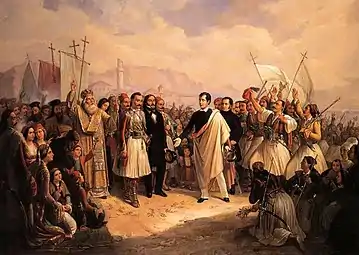
To help raise money for the revolution, Byron sold his estate Rochdale Manor in England, which raised some £11,250; this led Byron to estimate that he now had some £20,000 at his disposal, all of which he planned to spend on the Greek cause.[81] In today's money Byron would have been a millionaire many times over, and the news that a fabulously wealthy British aristocrat known for his generosity in spending money had arrived in Greece made Byron the object of much solicitation in a desperately poor country like Greece.[81] Byron wrote to his business agent in England, "I should not like to give the Greeks but a half helping hand", saying he would have wanted to spend his entire fortune on Greek freedom.[81] Byron found himself besieged by various people, both Greek and foreign, who tried to persuade Byron to open up his pocketbook to support them. By the end of March 1824, the so-called "Byron brigade" of 30 philhellene officers and about 200 men had been formed, paid for entirely by Byron.[82] Leadership of the Greek cause in the Roumeli region was divided between two rival leaders: a former Klepht (bandit), Odysseas Androutsos; and a wealthy Phanariot merchant, Alexandros Mavrokordatos. Byron used his prestige to attempt to persuade the two rival leaders to come together to focus on defeating the Ottomans.[83] At same time, other leaders of the Greek factions like Petrobey Mavromichalis and Theodoros Kolokotronis wrote letters to Byron telling him to disregard all of the Roumeliot leaders and to come to their respective areas in the Peloponnese. This drove Byron to distraction; he complained that the Greeks were hopelessly disunited and spent more time feuding with each other than trying to win independence.[84] Byron's friend Edward John Trelawny had aligned himself with Androutsos, who ruled Athens, and was now pressing for Byron to break with Mavrokordatos in favour of backing his rival Androutsos.[82] Androutsos, having won over Trelawny to his cause, was now anxious to persuade Byron to put his wealth behind his claim to be the leader of Greece.[85] Byron wrote with disgust about how one of the Greek captains, former Klepht Georgios Karaiskakis, attacked Missolonghi on 3 April 1824 with some 150 men supported by the Souliotes as he was unhappy with Mavrokordatos's leadership, leading to a brief bout of inter-Greek fighting before Karaiskakis was chased away by 6 April.[86]
Byron adopted a nine-year-old Turkish Muslim girl called Hato whose parents had been killed by the Greeks, whom he ultimately sent to safety in Kefalonia, knowing well that religious hatred between the Orthodox Greeks and Muslim Turks was running high and that any Muslim in Greece, even a child, was in serious danger.[87] Until 1934, most Turks did not have surnames, so Hato's lack of a surname was quite typical for a Turkish family at this time. During this time, Byron pursued his Greek page, Lukas Chalandritsanos, with whom he had fallen madly in love, but the affections went unrequited.[42][87] Byron was infatuated with the teenage Chalandritsanos, whom he spoiled outrageously, spending some £600 (the equivalent to about £24,600 in today's money) to cater to his every whim over the course of six months and writing his last poems about his passion for the Greek boy, but Chalandritsanos was only interested in Byron's money.[87] When the famous Danish sculptor Bertel Thorvaldsen heard about Byron's heroics in Greece, he voluntarily resculpted his earlier bust of Byron in Greek marble.[63]
Death
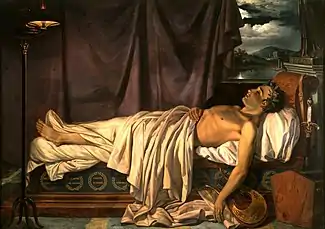
Mavrokordatos and Byron planned to attack the Turkish-held fortress of Lepanto, at the mouth of the Gulf of Corinth. Byron employed a fire-master to prepare artillery, and he took part of the rebel army under his own command, despite his lack of military experience. Before the expedition could sail, on 15 February 1824, he fell ill, and bloodletting weakened him further.[88] He made a partial recovery, but in early April he caught a violent cold, which therapeutic bleeding, insisted on by his doctors, aggravated. This treatment, carried out with unsterilised medical instruments, may have caused him to develop sepsis. He contracted a violent fever and died in Missolonghi on 19 April.[88]
His physician at the time, Julius van Millingen, son of Dutch–English archaeologist James Millingen, was unable to prevent his death. It has been said that if Byron had lived and had gone on to defeat the Ottomans, he might have been declared King of Greece. However, contemporary scholars have found such an outcome unlikely.[42] The British historian David Brewer wrote that in one sense, Byron was a failure in Greece as he failed to persuade the rival Greek factions to unite, won no victories and was successful only in the humanitarian sphere, using his great wealth to help the victims of the war, Muslim and Christian, but this did not affect the outcome of the Greek war of independence at all.[89]
Brewer went on to argue,
In another sense, though, Byron achieved everything he could have wished. His presence in Greece, and in particular his death there, drew to the Greek cause not just the attention of sympathetic nations, but their increasing active participation ... Despite the critics, Byron is primarily remembered with admiration as a poet of genius, with something approaching veneration as a symbol of high ideals, and with great affection as a man: for his courage and his ironic slant on life, for his generosity to the grandest of causes and to the humblest of individuals, for the constant interplay of judgment and sympathy. In Greece he is still revered as no other foreigner, and as very few Greeks are, and like a Homeric hero he is accorded an honorific standard epithet, megalos kai kalos, a great and good man.[90]
Post mortem
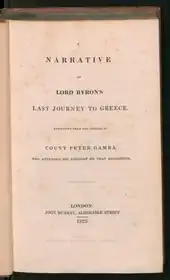
Alfred Tennyson would later recall the shocked reaction in Britain when word was received of Byron's death.[42] The Greeks mourned Lord Byron deeply, and he became a hero.[91][92] The national poet of Greece, Dionysios Solomos, wrote a poem about the unexpected loss, named To the Death of Lord Byron.[93] Βύρων, the Greek form of "Byron", continues in popularity as a masculine name in Greece, and a suburb of Athens is called Vyronas in his honour.
Byron's body was embalmed, but the Greeks wanted some part of their hero to stay with them. According to some sources, his heart remained at Missolonghi.[94] His other remains were sent to England (accompanied by his faithful manservant, "Tita") for burial in Westminster Abbey, but the Abbey refused for reason of "questionable morality".[42][95] Huge crowds viewed his coffin as he lay in state for two days in London.[42] He is buried at the Church of St. Mary Magdalene in Hucknall, Nottinghamshire.[96] A marble slab given by the King of Greece is laid directly above Byron's grave. His daughter, Ada Lovelace, was later buried beside him.[97]
Byron's friends raised the sum of £1,000 to commission a statue of the writer; Thorvaldsen offered to sculpt it for that amount.[63] However, for ten years after the statue was completed in 1834, most British institutions turned it down, and it remained in storage. The statue was refused by the British Museum, St. Paul's Cathedral, Westminster Abbey and the National Gallery[63] before Trinity College, Cambridge, finally placed the statue of Byron in its library.[63]
In 1969, 145 years after Byron's death, a memorial to him was finally placed in Westminster Abbey.[98][99] The memorial had been lobbied for since 1907: The New York Times wrote, "People are beginning to ask whether this ignoring of Byron is not a thing of which England should be ashamed ... a bust or a tablet might be put in the Poets' Corner and England be relieved of ingratitude toward one of her really great sons."[100]
Robert Ripley had drawn a picture of Boatswain's grave with the caption "Lord Byron's dog has a magnificent tomb while Lord Byron himself has none". This came as a shock to the English, particularly schoolchildren, who, Ripley said, raised funds of their own accord to provide the poet with a suitable memorial.[101]
Close to the centre of Athens, Greece, outside the National Garden, is a statue depicting Greece in the form of a woman crowning Byron. The statue is by the French sculptors Henri-Michel Chapu and Alexandre Falguière. Since 2008, the anniversary of Byron's death, 19 April, has been honoured in Greece as "Byron Day".[102]
Upon his death, the barony passed to Byron's cousin George Anson Byron, a career naval officer.
Personal life
Relationships and scandals

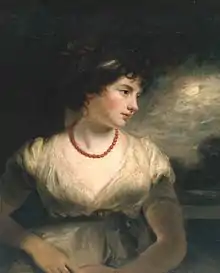 Jane Elizabeth Scott "Lady Oxford"
Jane Elizabeth Scott "Lady Oxford"
.jpg.webp) Anne Isabella Milbanke in 1812 by Charles Hayter
Anne Isabella Milbanke in 1812 by Charles Hayter
Byron described his first intense feelings at age eight for his distant cousin, Mary Duff:
My mother used always to rally me about this childish amour, and at last, many years after, when I was sixteen, she told me one day, 'O Byron, I have had a letter from Edinburgh, and your old sweetheart, Mary Duff, is married to Mr. C***.' And what was my answer? I really cannot explain or account for my feelings at that moment, but they nearly threw me into convulsions... How the deuce did all this occur so early? Where could it originate? I certainly had no sexual ideas for years afterwards; and yet my misery, my love for that girl were so violent, that I sometimes doubt if I have ever been really attached since. Be that as it may, hearing of her marriage several years after was like a thunder-stroke – it nearly choked me – to the horror of my mother and the astonishment and almost incredulity of every body. And it is a phenomenon in my existence (for I was not eight years old) which has puzzled, and will puzzle me to the latest hour of it; and lately, I know not why, the recollection (not the attachment) has recurred as forcibly as ever...But, the more I reflect, the more I am bewildered to assign any cause for this precocity of affection.[103]
Byron also became attached to Margaret Parker, another distant cousin.[38] While his recollection of his love for Mary Duff is that he was ignorant of adult sexuality during this time and was bewildered as to the source of the intensity of his feelings, he would later confess that:
My passions were developed very early – so early, that few would believe me – if I were to state the period – and the facts which accompanied it. Perhaps this was one of the reasons that caused the anticipated melancholy of my thoughts – having anticipated life.[104]
This is the only reference Byron himself makes to the event, and he is ambiguous as to how old he was when it occurred. After his death, his lawyer wrote to a mutual friend telling him a "singular fact" about Byron's life which was "scarcely fit for narration". But he disclosed it nonetheless, thinking it might explain Byron's sexual "propensities":
When nine years old at his mother's house a Free Scotch girl [May, sometimes called Mary, Gray, one of his first caretakers] used to come to bed to him and play tricks with his person.[105]
Gray later used this knowledge as a means of ensuring his silence if he were to be tempted to disclose the "low company" she kept during drinking binges.[106] She was later dismissed, supposedly for beating Byron when he was 11.[38]
A few years later, while he was still a child, Lord Grey De Ruthyn (unrelated to May Gray), a suitor of his mother's, also made sexual advances on him.[107] Byron's personality has been characterised as exceptionally proud and sensitive, especially when it came to his deformity.[17] His extreme reaction to seeing his mother flirting outrageously with Lord Grey De Ruthyn after the incident suggests this: he did not tell her of Grey's conduct toward him; he simply refused to speak to him again and ignored his mother's commands to be reconciled.[107] Leslie A. Marchand, one of Byron's biographers, theorises that Lord Grey De Ruthyn's advances prompted Byron's later sexual liaisons with young men at Harrow and Cambridge.[42]
Scholars acknowledge a more or less important bisexual component in Byron's very complex sentimental and sexual life. Bernhard Jackson asserts that "Byron's sexual orientation has long been a difficult, not to say contentious, topic, and anyone who seeks to discuss it must to some degree speculate, since the evidence is nebulous, contradictory and scanty... it is not so simple to define Byron as homosexual or heterosexual: he seems rather to have been both, and either."[108][109] Crompton states: "What was not understood in Byron's own century (except by a tiny circle of his associates) was that Byron was bisexual".[110] Another biographer, Fiona MacCarthy, has posited that Byron's true sexual yearnings were for adolescent males.[42] Byron used a code by which he communicated his homosexual Greek adventures to John Hobhouse in England: Bernhard Jackson recalls that "Byron's early code for sex with a boy" was "Plen(um). and optabil(em). -Coit(um)"[108] Bullough summarises:
Byron, was attached to Nicolo Giraud, a young French-Greek lad who had been a model for the painter Lusieri before Byron found him. Byron left him £7,000 in his will. When Byron returned to Italy, he became involved with a number of boys in Venice but eventually settled on Loukas Chalandritsanos, age 15, who was with him when he was killed [sic][111] (Crompton, 1985).
In 1812, Byron embarked on a well-publicised affair with the married Lady Caroline Lamb that shocked the British public.[112] She had spurned the attention of the poet on their first meeting, subsequently giving Byron what became his lasting epitaph when she famously described him as "mad, bad and dangerous to know".[113] This did not prevent her from pursuing him.[114][113]
Byron eventually broke off the relationship and moved swiftly on to others (such as that with Lady Oxford), but Lamb never entirely recovered, pursuing him even after he tired of her. She was emotionally disturbed and lost so much weight that Byron sarcastically commented to her mother-in-law, his friend Lady Melbourne, that he was "haunted by a skeleton".[115] She began to call on him at home, sometimes dressed in disguise as a pageboy,[112] at a time when such an act could ruin both of them socially. Once, during such a visit, she wrote on a book at his desk, "Remember me!" As a retort, Byron wrote a poem entitled Remember Thee! Remember Thee! which concludes with the line "Thou false to him, thou fiend to me".
As a child, Byron had seen little of his half-sister Augusta Leigh; in adulthood, he formed a close relationship with her that has been interpreted by some as incestuous,[115] and by others as innocent.[38] Augusta (who was married) gave birth on 15 April 1814 to her third daughter, Elizabeth Medora Leigh, rumoured by some to be Byron's.
Eventually Byron began to court Lady Caroline's cousin Anne Isabella Milbanke ("Annabella"), who refused his first proposal of marriage but later accepted him. Milbanke was a highly moral woman, intelligent and mathematically gifted; she was also an heiress. They married at Seaham Hall, County Durham, on 2 January 1815.[115]
The marriage proved unhappy. They had a daughter, Augusta Ada. On 16 January 1816, Lady Byron left him, taking Ada with her. That same year (21 April), Byron signed the Deed of Separation. Rumours of marital violence, adultery with actresses, incest with Augusta Leigh, and sodomy were circulated, assisted by a jealous Lady Caroline.[115] In a letter, Augusta quoted him as saying: "Even to have such a thing said is utter destruction and ruin to a man from which he can never recover." That same year Lady Caroline published her popular novel Glenarvon, in which Lord Byron was portrayed as the seedy title character.[116]
Children
 Elizabeth Medora Leigh (1814–1849)
Elizabeth Medora Leigh (1814–1849)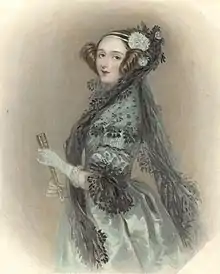 Ada Lovelace
Ada Lovelace
(1815–1852)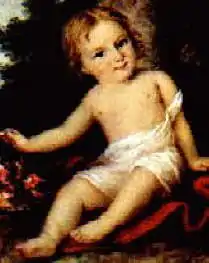 Clara Allegra Byron (1817–1822)
Clara Allegra Byron (1817–1822)
Byron wrote a letter to John Hanson from Newstead Abbey, dated 17 January 1809, that includes "You will discharge my Cook, & Laundry Maid, the other two I shall retain to take care of the house, more especially as the youngest is pregnant (I need not tell you by whom) and I cannot have the girl on the parish."[117] His reference to "The youngest" is understood to have been to a maid, Lucy, and the parenthesised remark to indicate himself as siring a son born that year. In 2010 part of a baptismal record was uncovered which apparently said: "September 24 George illegitimate son of Lucy Monk, illegitimate son of Baron Byron, of Newstead, Nottingham, Newstead Abbey."[118]
Augusta Leigh's child, Elizabeth Medora Leigh, born 1814, was very likely fathered by Byron, who was Augusta's half-brother.
Byron had a child, The Hon. Augusta Ada Byron ("Ada", later Countess of Lovelace), in 1815, by his wife Annabella Byron, Lady Byron (née Anne Isabella Milbanke, or "Annabella"), later Lady Wentworth. Ada Lovelace, notable in her own right, collaborated with Charles Babbage on the analytical engine, a predecessor to modern computers. She is recognised[119] as one of[120] the world's first computer programmers.
He also had an extramarital child in 1817, Clara Allegra Byron, with Claire Clairmont, stepsister of Mary Shelley and stepdaughter of William Godwin, writer of Political Justice and Caleb Williams. Allegra is not entitled to the style "The Hon." as is usually given to the daughter of barons, since she was born outside of his marriage. Born in Bath in 1817, Allegra lived with Byron for a few months in Venice; he refused to allow an Englishwoman caring for the girl to adopt her and objected to her being raised in the Shelleys' household.[63] He wished for her to be brought up Catholic and not marry an Englishman, and he made arrangements for her to inherit 5,000 lira upon marriage or when she reached the age of 21, provided she did not marry a native of Britain. However, the girl died aged five of a fever in Bagnacavallo, Italy, while Byron was in Pisa; he was deeply upset by the news. He had Allegra's body sent back to England to be buried at his old school, Harrow, because Protestants could not be buried in consecrated ground in Catholic countries. At one time he himself had wanted to be buried at Harrow. Byron was indifferent towards Allegra's mother, Claire Clairmont.[63]
Sea and swimming
Byron enjoyed adventure, especially relating to the sea.[20]
The first recorded notable example of open water swimming took place on 3 May 1810 when Lord Byron swam from Europe to Asia across the Hellespont Strait.[121] This is often seen as the birth of the sport and pastime, and to commemorate it, the event is recreated every year as an open water swimming event.[122]
Whilst sailing from Genoa to Cephalonia in 1823, every day at noon, Byron and Trelawny, in calm weather, jumped overboard for a swim without fear of sharks, which were not unknown in those waters. Once, according to Trelawny, they let the geese and ducks loose and followed them and the dogs into the water, each with an arm in the ship Captain’s new scarlet waistcoat, to the annoyance of the Captain and the amusement of the crew.{sfn|Prell|2009a|p=13}}
Fondness for animals
Byron had a great love of animals, most notably for a Newfoundland dog named Boatswain. When the animal contracted rabies, Byron nursed him, albeit unsuccessfully, without any thought or fear of becoming bitten and infected.[123][124]
Although deep in debt at the time, Byron commissioned an impressive marble funerary monument for Boatswain at Newstead Abbey, larger than his own, and the only building work which he ever carried out on his estate. In his 1811 will, Byron requested that he be buried with him.[63] The 26‐line poem "Epitaph to a Dog" has become one of his best-known works, but a draft of an 1830 letter by Hobhouse shows him to be the author, and that Byron decided to use Hobhouse's lengthy epitaph instead of his own, which read: "To mark a friend's remains these stones arise/I never knew but one – and here he lies."[125]
Byron also kept a tame bear while he was a student at Trinity, out of resentment for rules forbidding pet dogs like his beloved Boatswain. There being no mention of bears in their statutes, the college authorities had no legal basis for complaining: Byron even suggested that he would apply for a college fellowship for the bear.[126]
During his lifetime, in addition to numerous cats, dogs, and horses, Byron kept a fox, monkeys, an eagle, a crow, a falcon, peacocks, guinea hens, an Egyptian crane, a badger, geese, a heron, and a goat.[127] Except for the horses, they all resided indoors at his homes in England, Switzerland, Italy, and Greece.[2]
Health and appearance

Character and psyche
I am such a strange mélange of good and evil that it would be difficult to describe me.[128]
As a boy, Byron's character is described as a "mixture of affectionate sweetness and playfulness, by which it was impossible not to be attached", although he also exhibited "silent rages, moody sullenness and revenge" with a precocious bent for attachment and obsession.[103]
Deformed foot
From birth, Byron suffered from a deformity of his right foot. Although it has generally been referred to as a "club foot", some modern medical authors maintain that it was a consequence of infantile paralysis (poliomyelitis), and others that it was a dysplasia, a failure of the bones to form properly.[129] Whatever the cause, he was afflicted with a limp that caused him lifelong psychological and physical misery, aggravated by painful and pointless "medical treatment" in his childhood and the nagging suspicion that with proper care it might have been cured.[130]
He was extremely self-conscious about this from a young age, nicknaming himself le diable boîteux[131] (French for "the limping devil", after the nickname given to Asmodeus by Alain-René Lesage in his 1707 novel of the same name). Although he often wore specially-made shoes in an attempt to hide the deformed foot,[42] he refused to wear any type of brace that might improve the limp.[20]
Scottish novelist John Galt felt his oversensitivity to the "innocent fault in his foot was unmanly and excessive" because the limp was "not greatly conspicuous". He first met Byron on a voyage to Sardinia and did not realise he had any deficiency for several days, and still could not tell at first if the lameness was a temporary injury or not. At the time Galt met him he was an adult and had worked to develop "a mode of walking across a room by which it was scarcely at all perceptible".[22] The motion of the ship at sea may also have helped to create a favourable first impression and hide any deficiencies in his gait, but Galt's biography is also described as being "rather well-meant than well-written", so Galt may be guilty of minimising a defect that was actually still noticeable.[132]
Physical appearance
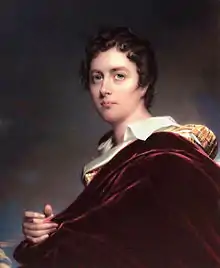
Byron's adult height was 5 feet 8.5 inches (1.74 m), his weight fluctuating between 9.5 stone (133 lb; 60 kg) and 14 stone (200 lb; 89 kg). He was renowned for his personal beauty, which he enhanced by wearing curl-papers in his hair at night.[133] He was athletic, being a competent boxer and horse-rider and an excellent swimmer. He attended pugilistic tuition at the Bond Street rooms of former prizefighting champion 'Gentleman' John Jackson, whom Byron called 'the Emperor of Pugilism', and recorded these sparring sessions in his letters and journals.[134]
Byron and other writers, such as his friend Hobhouse, described his eating habits in detail. At the time he entered Cambridge, he went on a strict diet to control his weight. He also exercised a great deal, and at that time wore a great amount of clothes to cause himself to perspire. For most of his life he was a vegetarian and often lived for days on dry biscuits and white wine. Occasionally he would eat large helpings of meat and desserts, after which he would purge himself. Although he is described by Galt and others as having a predilection for "violent" exercise, Hobhouse suggests that the pain in his deformed foot made physical activity difficult and that his weight problem was the result.[133]
Trelawny who observed Byron's eating habits noted that he lived on a diet of biscuits and soda-water for days at a time and then would eat a "horrid mess of cold potatoes, rice, fish, or greens, deluged in vinegar, and gobble it up like a famished dog."[135][136]
Political career
Byron first took his seat in the House of Lords 13 March 1809[137] but left London on 11 June 1809 for the Continent.[138] Byron's association with the Holland House Whigs provided him with a discourse of liberty rooted in the Glorious Revolution of 1688.[139] A strong advocate of social reform, he received particular praise as one of the few Parliamentary defenders of the Luddites: specifically, he was against a death penalty for Luddite "frame breakers" in Nottinghamshire, who destroyed textile machines that were putting them out of work. His first speech before the Lords, on 27 February 1812, was loaded with sarcastic references to the "benefits" of automation, which he saw as producing inferior material as well as putting people out of work, and concluded the proposed law was only missing two things to be effective: "Twelve Butchers for a Jury and a Jeffries for a Judge!". Byron's speech was officially recorded and printed in Hansard.[140] He said later that he "spoke very violent sentences with a sort of modest impudence" and thought he came across as "a bit theatrical".[141] The full text of the speech, which he had previously written out, was presented to Dallas in manuscript form and he quotes it in his work.[142]
Two months later, in conjunction with the other Whigs, Byron made another impassioned speech before the House of Lords in support of Catholic emancipation.[139][143] Byron expressed opposition to the established religion because it was unfair to people of other faiths.[144]
These experiences inspired Byron to write political poems such as Song for the Luddites (1816) and The Landlords' Interest, Canto XIV of The Age of Bronze.[145] Examples of poems in which he attacked his political opponents include Wellington: The Best of the Cut-Throats (1819) and The Intellectual Eunuch Castlereagh (1818).[146]
Poetic works
Byron wrote prolifically.[147] In 1832 his publisher, John Murray, released the complete works in 14 duodecimo volumes, including a life[141] by Thomas Moore. Subsequent editions were released in 17 volumes, first published a year later, in 1833. An extensive collection of his works, including early editions and annotated manuscripts, are held within the John Murray Archive at the National Library of Scotland in Edinburgh.
Don Juan
Byron's magnum opus, Don Juan, a poem spanning 17 cantos, ranks as one of the most important long poems published in England since John Milton's Paradise Lost.[148] The poem, often called the epic of its time, has roots deep in literary tradition and, although regarded by early Victorians as somewhat shocking, equally involves itself with its own contemporary world at all levels – social, political, literary and ideological. In addition to its biting satire, the poem (especially in the early cantos) is funny.[149]
Byron published the first two cantos anonymously in 1819 after disputes with his regular publisher over the shocking nature of the poetry. By this time, he had been a famous poet for seven years, and when he self-published the beginning cantos, they were well received in some quarters. It was then released volume by volume through his regular publishing house.[43] By 1822, cautious acceptance by the public had turned to outrage, and Byron's publisher refused to continue to publish the works. In Canto III of Don Juan, Byron expresses his detestation for poets such as William Wordsworth and Samuel Taylor Coleridge.[43][150] In letters to Francis Hodgson, Byron referred to Wordsworth as "Turdsworth".[151]
Irish Avatar
Byron wrote Irish Avatar in connection with the trip of the King of the United Kingdom George IV to Ireland. Byron's official interpretation of this fact is contrasted with the indignation of British tyranny imbued with angry copyright. Byron's satire is directed against both despotism and lackey. In his satire, the poet is indignant at the anguish of those who crawled before George, as before the new "god". The author reminds the Irish that in the person of George IV they should see the British government, which took away all their freedoms. The lyrical hero calls on the Irish to fight against British tyranny and speaks of their love for those Irish who are fighting for the freedom of their country.
Parthenon marbles
Byron was a bitter opponent of Lord Elgin's removal of the Parthenon marbles from Greece and "reacted with fury" when Elgin's agent gave him a tour of the Parthenon, during which he saw the spaces left by the missing friezes and metopes. He denounced Elgin's actions in his poem The Curse of Minerva and in Canto II (stanzas XI–XV) of Childe Harold's Pilgrimage.[152]
Legacy and influence
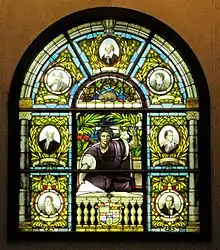
Byron is considered to be the first modern-style celebrity. His image as the personification of the Byronic hero fascinated the public, and his wife Annabella coined the term "Byromania" to refer to the commotion surrounding him.[42] His self-awareness and personal promotion are seen as a beginning to what would become the modern rock star; he would instruct artists painting portraits of him not to paint him with pen or book in hand, but as a "man of action."[42] While Byron first welcomed fame, he later turned from it by going into voluntary exile from Britain.[31]
Biographies were distorted by the burning of Byron's memoir in the offices of his publisher, John Murray, a month after his death and the suppression of details of Byron's bisexuality by subsequent heads of the firm (which held the richest Byron archive). As late as the 1950s, scholar Leslie Marchand was expressly forbidden by the Murray company to reveal details of Byron's same-sex passions.[42]
The re-founding of the Byron Society in 1971 reflected the fascination that many people had with Byron and his work.[153] This society became very active, publishing an annual journal. Thirty-six Byron Societies function throughout the world, and an International Conference takes place annually.
Byron exercised a marked influence on Continental literature and art, and his reputation as a poet is higher in many European countries than in Britain or America, although not as high as in his time, when he was widely thought to be the greatest poet in the world.[31] Byron's writings also inspired many composers. Over forty operas have been based on his works, in addition to three operas about Byron himself (including Virgil Thomson's Lord Byron). His poetry was set to music by many Romantic composers, including Beethoven, Schubert, Rossini, Mendelssohn, Schumann and Carl Loewe. Among his greatest admirers was Hector Berlioz, whose operas and Mémoires reveal Byron's influence.[154]
Byronic hero
The figure of the Byronic hero pervades much of his work, and Byron himself is considered to epitomise many of the characteristics of this literary figure.[42] The use of a Byronic hero by many authors and artists of the Romantic movement show Byron's influence during the 19th century and beyond, including the Brontë sisters.[42][155] His philosophy was more durably influential in continental Europe than in England; Friedrich Nietzsche admired him, and the Byronic hero was echoed in Nietzsche's superman.[156]
The Byronic hero presents an idealised, but flawed character whose attributes include: great talent; great passion; a distaste for society and social institutions; a lack of respect for rank and privilege (although possessing both); being thwarted in love by social constraint or death; rebellion; exile; an unsavory secret past; arrogance; overconfidence or lack of foresight; and, ultimately, a self-destructive manner. These types of characters have since become ubiquitous in literature and politics.
In popular culture
Bibliography
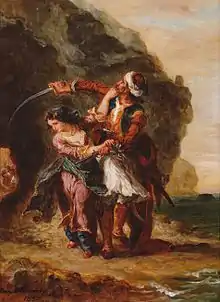
Major works
- Hours of Idleness (1807)
- Lachin y Gair (1807)
- English Bards and Scotch Reviewers (1809)
- Childe Harold's Pilgrimage, Cantos I & II (1812)
- The Giaour (1813) (text on Wikisource)
- The Bride of Abydos (1813)
- The Corsair (1814) (text on Wikisource)
- Lara, A Tale (1814) (text on Wikisource)
- Hebrew Melodies (1815)
- The Siege of Corinth (1816) (text on Wikisource)
- Parisina (1816) (text on Wikisource)
- The Prisoner of Chillon (1816) (text on Wikisource)
- The Dream (1816) (text on Wikisource)
- Prometheus (1816) (text on Wikisource)
- Darkness (1816) (text on Wikisource)
- Manfred (1817) (text on Wikisource)
- The Lament of Tasso (1817)
- Beppo (1818) (text on Wikisource)
- Childe Harold's Pilgrimage (1818) (text on Wikisource)
- Don Juan (1819–1824; incomplete on Byron's death in 1824) (text on Wikisource)
- Mazeppa (1819)
- The Prophecy of Dante (1819)
- Marino Faliero (1820)
- Sardanapalus (1821)
- The Two Foscari (1821)
- Cain (1821)
- The Vision of Judgment (1821)
- Heaven and Earth (1821)
- Werner (1822)
- The Age of Bronze (1823)
- The Island (1823) (text on Wikisource)
- The Deformed Transformed (1824)
- Letters and journals, vol. 1 (1830)
- Letters and journals, vol. 2 (1830)
Selected shorter lyric poems
- Maid of Athens, ere we part (1810) (text on Wikisource)
- And thou art dead (1812) (text on Wikisource)
- She Walks in Beauty (1814) (text on Wikisource)
- My Soul is Dark (1815) (text on Wikisource)
- The Destruction of Sennacherib (1815) (text on Wikisource)
- Monody on the Death of the Right Hon. R. B. Sheridan (1816) (text on Wikisource)
- Fare Thee Well (1816) (text on Wikisource)
- So, we'll go no more a roving (1817) (text on Wikisource)
- When We Two Parted (1817) (text on Wikisource)
- Ode on Venice (1819) (text on Wikisource)
- Stanzas (1819)
- Don Leon (not by Lord Byron, but attributed to him; 1830s)
See also
- Early life of Lord Byron
- Timeline of Lord Byron
- 19th century in poetry
- Bridge of Sighs, a Venice landmark Byron denominated
- Asteroid 3306 Byron
References
- McGann, Jerome (2004). "Byron, George Gordon Noel, sixth Baron Byron (1788–1824), poet". Oxford Dictionary of National Biography (online ed.). Oxford University Press. doi:10.1093/ref:odnb/4279. ISBN 9780198614128. Retrieved 8 February 2021. (Subscription or UK public library membership required.)
- "Lord Byron". The British Library. Retrieved 17 October 2020.
- Marchand, Leslie A. (15 April 2019). "Lord Byron". Encyclopædia Britannica. London, England: Encyclopædia Britannica, Inc.
- "Byron and Scotland". Robert Morrison.com.
- Foundation, Poetry (30 December 2018). "Lord Byron (George Gordon)". Poetry Foundation. Retrieved 30 December 2018.
- "The Nation's Favourite Poet Result – TS Eliot is your winner!". London, England: BBC. Retrieved 25 May 2019.
- Perrottet, Tony (29 May 2011). "Lake Geneva as Shelley and Byron Knew It". The New York Times. New York City: New York Times Company.
- "Byron had yet to die to make philhellenism generally acceptable." – Plomer (1970).
- Fuegi, J; Francis, J (October–December 2003). "Lovelace & Babbage and the creation of the 1843 'notes'". IEEE Annals of the History of Computing. Washington DC: IEEE Computer Society. 25 (4): 16–26. doi:10.1109/MAHC.2003.1253887.
- Phillips, Ana Lena (November–December 2011). "Crowdsourcing Gender Equity: Ada Lovelace Day, and its companion website, aims to raise the profile of women in science and technology". American Scientist. Research Triangle Park, North Carolina: Xi Society. 99 (6): 463. doi:10.1511/2011.93.463.
- "Ada Lovelace honoured by Google doodle". The Guardian. London, England: Guardian Media Group. 10 December 2012. Retrieved 10 December 2012.
- Boase & Courtney (1878), p. 792.
- Brand 2020, p. 183.
- Brand 2020, p. 181.
- Brand 2020, pp. 189, 200.
- Brand 2020, p. 212.
- Galt (1830), Chapter 1.
- Brand 2020, p. 221.
- Brand 2020, p. 236.
- "Byron as a Boy; His Mother's Influence – His School Days and Mary Chaworth" (PDF). The New York Times. 26 February 1898. Retrieved 11 July 2008.
- Brand 2020, p. 254.
- Galt (1830), Chapter 3.
- McGann (2013).
- Williamson, Martin (18 June 2005). "The oldest fixture of them all: the annual Eton vs Harrow match". Cricinfo Magazine. London, England: Wisden Group. Retrieved 23 July 2008.
- MacCarthy 2002, p. 33.
- MacCarthy 2002, p. 37.
- MacCarthy 2002, p. 404.
- MacCarthy 2002, p. 40.
- MacCarthy 2002, p. 5.
- "Byron [post Noel], George (Gordon), Baron Byron (BRN805G)". A Cambridge Alumni Database. University of Cambridge.
- Allen (2003).
- MacCarthy 2002, p. 61.
- MacCarthy 2002, p. 39.
- Fone, Byrne (1998). The Columbia Anthology of Gay Literature: Readings from Western Antiquity to the Present Day. New York City: Columbia University Press. p. 219. ISBN 978-0231096706.
- Biography.com Editors (2016). "Lord Byron Biography". A&E Television Networks.
- Fugitive Pieces. December 1933. ISBN 9780841432437. Retrieved 29 September 2015.
- Lord Byron. "To Mary". JGHawaii Publishing Co. Retrieved 20 November 2008.
- Hoeper, Jeffrey D. (17 December 2002). "The Sodomizing Biographer: Leslie Marchand's Portrait of Byron". Arkansas State University. Archived from the original on 10 May 2003. Retrieved 11 July 2008.
- Dallas 1824, p. 18.
- Dallas 1824, p. 46.
- Dallas 1824, p. 55.
- Bostridge, Mark (3 November 2002). "On the trail of the real Lord Byron". The Independent on Sunday. London. Retrieved 22 July 2008.
- Stabler (1999).
- Moore, Thomas (2006). "Letters and Journals of Lord Byron, 1830, volume 1". In Ratcliffe, Susan (ed.). The Concise Oxford Dictionary of Quotations. Oxford, England: Oxford University Press.
- Lansdown (2012).
- Crompton (1985), pp. 123–128.
- Blackstone (1974).
- Marchand, p. 45.
- Byron's correspondence and Journals from the Mediterranean, July 1809 – July 1811 Byron to Catherine Gordon Byron, from Gibraltar, 11 August 1809: "I left Seville and rode on to Cadiz through a beautiful country, at Xeres where the Sherry we drink is made I met a great merchant a Mr Gordon of Scotland, who was extremely polite and favoured me with the Inspection of his vaults & cellars so that I quaffed at the Fountain head. – – Cadiz, sweet Cadiz! is the most delightful town I ever beheld..."
- Christensen (1993).
- MacCarthy 2002, p. 135.
- Tuite (2015), p. 156.
- http://www.euromanticism.org/the-hellespont/
- "Lord Byron, 19th-century bad boy". The British Library. Retrieved 17 October 2020.
- Alexander Kilgour, Anecdotes of Lord Byron: From Authentic Sources; with Remarks Illustrative of His Connection with the Principal Literary of the Present Day, Knight and Lacey, London (1925) - Google Books pg. 32
- John Galt, The Complete Works of Lord Byron, Volume 2, Baudry's European Library (1837) - Google Books cvii
- Rubin, Merle (10 September 1989). "A Hero to His Physician: Lord Byron's Doctor by Paul West". Los Angeles Times. ISSN 0458-3035. Retrieved 26 December 2017.
- Silvia Bordoni (2005). "Lord Byron and Germaine de Staël" (PDF). University of Nottingham.
- "The Vampyre by John Polidori". British Library.
- Rigby, Mair (November 2004). ""Prey to some cureless disquiet": Polidori's Queer Vampyre at the Margins of Romanticism". Romanticism on the Net (36–37).
- "John Polidori & the Vampyre Byron". www.angelfire.com. Retrieved 26 December 2017.
- "'A Fragment', from Mazeppa by Lord George Byron". British Library.
- Elze (1872).
- (in Armenian) Soghomonyan, Soghomon A. "Բայրոն, Ջորջ Նոել Գորդոն" (Byron, George Noel Gordon). Soviet Armenian Encyclopedia. vol. ii. Yerevan, Armenian SSR: Armenian Academy of Sciences, 1976, pp. 266–267.
- Shelley, Percy (1964). Letters: Shelley in Italy. Clarendon Press. p. 330.
- Moore, Thomas, Letters and Journals of Lord Byron, London, 1830, p. 612
- Lovell 1954, p. 368.
- Prell, Donald (2010). A Biography of Captain Daniel Roberts. Palm Springs, CA: Strand Publishing. p. 66.
- Lovell 1954, p. 369.
- Brewer 2011, p. 197.
- Brewer 2011, pp. 197, 199.
- Prell 2009a.
- Prell 2009b.
- Brewer 2011, p. 201.
- Brewer 2011, p. 202.
- Brewer 2011, p. 205.
- Brewer 2011, pp. 207–208.
- Brewer 2011, p. 212.
- Brewer 2011, p. 210.
- Brewer 2011, p. 211.
- Brewer 2011, p. 213.
- Brewer 2011, p. 215.
- Brewer 2011, pp. 215–216.
- Brewer 2011, pp. 216–217.
- Brewer 2011, p. 216.
- Brewer 2011, p. 217.
- Brewer 2011, p. 214.
- Neil Fraistat; Steven E Jones. "The Byron Chronology". Romantic Circles. University of Maryland. Retrieved 15 May 2012.
- Brewer 2011, p. 219.
- Brewer 2011, pp. 215–219.
- Edgcumbe (1972), pp. 185–190.
- Gamba (1975).
- Dionysios Solomos. "Εις το Θάνατο του Λόρδου Μπάιρον" [To the Death of Lord Byron] (in Greek). Retrieved 20 November 2008.
- "Heart Burial". Time. 31 July 1933. Archived from the original on 8 August 2013. Retrieved 20 November 2008.
- Mondragon, Brenda C. "Lord Byron". Neurotic Poets. Retrieved 20 November 2008.
- Wilson, Scott. Resting Places: The Burial Sites of More Than 14,000 Famous Persons, 3d ed.: 2 (Kindle Locations 6724–6725). McFarland & Company, Inc., Publishers. Kindle Edition.
- Pevsner (1951), p. 85.
- "Westminster Abbey Poets' Corner". Dean and Chapter of the Collegiate Church of St. Peter Westminster. Retrieved 31 May 2009.
- "Westminster Abbey Lord Byron". Dean and Chapter of the Collegiate Church of St. Peter Westminster. Retrieved 27 April 2016.
- "Byron Monument for the Abbey: Movement to Get Memorial in Poets' Corner Is Begun" (PDF). The New York Times. 12 July 1907. Retrieved 11 July 2008.
- Ripley's Believe It or Not!, 3rd Series, 1950; p. xvi.
- Martin Wainwright (18 October 2008). "Greeks honour fallen hero Byron with a day of his own". The Guardian. Retrieved 4 May 2017.
- Moore, Thomas, The Works of Lord Byron: With His Letters and Journals, and His Life, John Murray, 1835.
- Marchand 1982, p. 277.
- Marchand 1957, p. 139.
- Marchand 1957, p. 435.
- Marchand 1957, p. 442.
- Emily A. Bernhard Jackson, "Least Like Saints: The Vexed Issue of Byron's Sexuality, The Byron Journal, (2010) 38#1 pp. 29–37.
- Crompton (1985).
- Crompton, Louis (8 January 2007). "Byron, George Gordon, Lord". glbtq.com. Archived from the original on 11 April 2014. Retrieved 16 October 2011.
- Contrary to later misconception, Byron was not killed in battle nor died from battle wounds. See also The Dictionary of Misinformation (1975) by Tom Burname, Futura Publications, 1985, pp. 39–40.
- Wong, Ling-Mei (14 October 2004). "Professor to speak about his book, 'Lady Caroline Lamb'". Spartan Daily. San Jose State University. Archived from the original on 7 December 2008. Retrieved 11 July 2008.
- Castle, Terry (13 April 1997). "'Mad, Bad and Dangerous to Know': A biography that sees Lord Byron as a victim of circumstances". The New York Times. NYC, USA. Retrieved 19 November 2008.
- "Ireland: Poetic justice at home of Byron's exiled lover". Sunday Times: Property. Dublin, Ireland: The Times Online. 17 November 2002. Retrieved 21 February 2010.
'Mad, bad and dangerous to know' has become Lord Byron's lasting epitaph. Lady Caroline Lamb coined the phrase after her first meeting with the poet at a society event in 1812.
- "Lady Caroline Lamb – Lord Byron's Lovers". Retrieved 20 November 2008.
- Barger (2011), p. 15.
- Marchand, Byron's Letters and Journals, 1982.
- "Mystery of Byron, an illegitimate child and Linby church". Hucknall Dispatch. 1 June 2010. Archived from the original on 24 June 2015.
- "Ada Byron, Lady Lovelace". Retrieved 11 July 2010.
- "Ada Lovelace: Original and Visionary, but No Programmer". OpenMind. 9 December 2015. Retrieved 3 April 2019.
- "Lord Byron swims the Hellespont". History.com. 3 May 1810. Archived from the original on 6 March 2009. Retrieved 5 March 2012.
- Matt Barr (30 September 2007). "The day I swam all the way to Asia". The Guardian. London. Retrieved 5 March 2012.
- "Boatswain is dead! He expired in a state of madness on the 10th, after suffering much, yet retaining all the gentleness of his nature to the last, never attempting to do the least injury to anyone near him." Marchand, Leslie A. (ed.), Byron's Letters and Journals (BLJ), Johns Hopkins 2001, Letter to Francis Hodgson, 18 November 1808.
- "... the poor animal having been seized with a fit of madness, at the commencement of which so little aware was Lord Byron of the nature of the malady, that more than once, with his bare hand, he wiped away the slaver from the dog's lips during the paroxysm." Moore, Thomas. Letters and Journals of Lord Byron, 1833.
- Moore, Doris Langley. The Late Lord Byron. Melville House Publishing, 1961, ch. 10.
- "I have got a new friend, the finest in the world, a tame bear. When I brought him here, they asked me what I meant to do with him, and my reply was, 'he should sit for a fellowship.'" Marchand, Leslie A. (ed.), Byron's Letters and Journals (BLJ), Johns Hopkins 2001, Letter to Elizabeth Pigot, 26 October 1807:(BLJ I 135-6).
- Cochran (2011), pp. 176–177.
- Marchand 1957, p. 7.
- MacCarthy 2002, pp. 3–4.
- Gilmour, Ian (2003). The Making of the Poets: Byron and Shelley in Their Time. Carroll & Graf Publishers. p. 35.
- "For Byron, his deformed foot became the crucial catastrophe of his life. He saw it as the mark of satanic connection, referring to himself as le diable boiteux, the lame devil." – Eisler (1999), p. 13.
- Henley, William Ernest, ed., The works of Lord Byron: Letters, 1804–1813, Volume 1, 1897
- Baron (1997).
- David Snowdon, Writing the Prizefight: Pierce Egan's Boxiana World (Bern, 2013).
- Trelawny, Edward John (2011 edition). Recollections of the Last Days of Shelley and Byron. Cambridge University Press. p. 48. ISBN 978-1-108-03405-0
- Coghlan, J. Michelle (2020). The Cambridge Companion to Literature and Food. Cambridge University Press. p. 53. ISBN 978-1108446105
- Dallas 1824, p. 33.
- Dallas 1824, p. 65.
- Bone, Drummond (2004). The Cambridge Companion to Byron. Cambridge University Press. pp. 44–47.
- Byron's speech of 27 February 1812, in T.C. Hansard (1812) The Parliamentary Debates, vol. 21, pp. 966–972
- Moore, Thomas (1829) [1851]. John Wilson Croker (ed.). The Life of Lord Byron: With His Letters and Journals. I. John Murray. pp. 154, 676. Retrieved 20 November 2008.
- Dallas 1824, p. 205.
- Byron's speech of 21 April 1812, in T.C. Hansard (1812) The Parliamentary Debates, vol. 22, p.642-53
- Byron's speech of 21 April 1812, in T. C. Hansard (1812) The Parliamentary Debates, vol. 22, p. 679.
- Lord Byron (April 1823). "The Age of Bronze". JGHawaii Publishing Co. Retrieved 20 November 2008.
- Gordon, George. "Don Juan: Dedication".
- "List of Byron's works". Archived from the original on 24 June 2019. Retrieved 20 November 2008.
- Lansdown (2012), p. 129.
- Hanson, Marilee. "Don Juan Canto". English History. Retrieved 30 July 2016.
- Lord Byron. .
- Brown, Mark (27 September 2009). "Lord Byron's dig at William 'Turdsworth'". The Guardian. Retrieved 2 July 2014.
- Atwood (2006), p. 136.
- "The Byron Society". Retrieved 29 January 2021.
- Warrack, John (2001). "Byron, Lord". In Root, Deane L. (ed.). The New Grove Dictionary of Music and Musicians. Oxford University Press.
- Franklin (2013), pp. 127–128.
- Russell (2004), pp. 675–680, 688.
Notes
![]() This article incorporates text from a publication now in the public domain: Cousin, John William (1910). A Short Biographical Dictionary of English Literature. London: J. M. Dent & Sons – via Wikisource.
This article incorporates text from a publication now in the public domain: Cousin, John William (1910). A Short Biographical Dictionary of English Literature. London: J. M. Dent & Sons – via Wikisource.
Bibliography
- Allen, Brooke (2003). "Byron: revolutionary, libertine and friend". The Hudson Review. 56 (2): 369–376. doi:10.2307/3853260. JSTOR 3853260.
- Atwood, Roger (2006). Stealing History: Tomb Raiders, Smugglers, And the Looting of the Ancient World. New York: St. Martin's Press. ISBN 0-312-32407-3.
- Barger, Andrew (2011). BlooDeath: The Best Vampire Short Stories 1800–1849. Collierville, TN: Bottletree Books. ISBN 978-1-933747-35-4. Archived from the original on 15 August 2017. Retrieved 25 May 2013.
- Baron, J. H. (1997). "Illnesses and creativity: Byron's appetites, James Joyce's gut, and Melba's meals and mésalliances". British Medical Journal. 315 (7123): 1697–1703. doi:10.1136/bmj.315.7123.1697. PMC 2128026. PMID 9448545.
- Blackstone, Bernard (1974). "Byron and Islam: the triple Eros". Journal of European Studies. 4 (4): 325–363. doi:10.1177/004724417400400401. S2CID 162373838.
- Boase, George Clement; Courtney, William Prideaux (1878). Bibliotheca Cornubiensis: a Catalogue of the Writings of Cornishmen. II. London: Longmans, Green, Reader and Dyer. Retrieved 19 November 2008.
- Bone, Drummond (2004). The Cambridge Companion to Byron. Cambridge University Press. ISBN 978-0-521-78676-8.
- Brewer, David (2011). The Greek War of Independence. London: Overlook Duckworth. ISBN 9781585671724.
- Bullough, Vern L. (1990). "History in adult human sexual behavior with children and adolescents in Western societies". In Jay R. Felerman (ed.). Pedophilia: Biosocial Dimensions. New York: Springer-Verlag. pp. 69–90. doi:10.1007/978-1-4613-9682-6_3. ISBN 9781461396840.
- Christensen, Jerome (1993). Lord Byron's Strength: Romantic Writing and Commercial Society. Baltimore, MD: Johns Hopkins University Press. ISBN 9780801843563.
- Cochran, Peter (2011). Byron and Italy. Newcastle-upon-Tyne: Cambridge Scholars. ISBN 978-1-4438-3602-9.
- Crompton, Louis (1985). Byron and Greek Love: Homophobia in 19th Century England. University of California Press. ISBN 978-0-520-05172-0.
- Dallas, Alexander Robert Charles (1824). Recollections of the life of Lord Byron, from the year 1808 to the end of 1814. London: Charles Knight.
- Edgcumbe, Richard (1972). Byron: the Last Phase. New York: Haskell House.
- Eisler, Benita (1999). Byron: Child of Passion, Fool of Fame. Chapter one: Alfred A. Knopf. ISBN 0-679-41299-9. (online at The New York Times)
- Elze, Karl Friedrich (1872). Lord Byron, a Biography. London: John Murray.
- Franklin, Caroline (2013). The Female Romantics: Nineteenth-century Women Novelists and Byronism. Routledge. ISBN 978-0-415-99541-2.
- Galt, John (1830). The Life of Lord Byron. London: Henry Colburn and Richard Bentley.
- Gamba, Pietro (1975). A Narrative of Lord Byron's Last Journey to Greece: Extracted from the journal of Count Peter Gamba, who attended his lordship on that expedition. Folcroft Library Editions.
- Lansdown, Richard (2012). The Cambridge Introduction to Byron. Cambridge University Press. ISBN 978-0-521-11133-1.
- Larman, Alexander (2016). Byron's Women. Head of Zeus. ISBN 978-1784082024.
- Lovell, Ernest J., ed. (1954). His Very Self and Voice, Collected Conversations of Lord Byron. New York: MacMillan.
- MacCarthy, Fiona (2002). Byron: Life and Legend. John Murray. ISBN 978-0-7195-5621-0.
- Marchand, Leslie (1957). Byron: A Life. Alfred A. Knopf.
- Marchand, Leslie A., ed. (1982). Lord Byron: Selected Letters and Journals. Cambridge, Massachusetts: Harvard University Press. ISBN 9780674539150.
- Mayne, Ethel Colburn (1912). Byron. 1. C. Scribner's sons.
- McGann, Jerome (2013) [2004]. "Byron, George Gordon Noel (1788–1824)". Oxford Dictionary of National Biography (online ed.). Oxford University Press. doi:10.1093/ref:odnb/4279. (Subscription or UK public library membership required.)
- Pevsner, N. (1951). Nottinghamshire. Pevsner Architectural Guides: Buildings of England. Harmondsworth: Penguin.
- Plomer, William (1970) [1936]. The Diamond of Jannina. New York: Taplinger Publishing. ISBN 978-0-224-61721-5.
- Prell, Donald B. (2009a). Sailing with Byron from Genoa to Cephalonia (1823). Palm Springs, CA: Strand Publishing. ISBN 978-0-9741975-5-5.
- Prell, Donald B. (2009b). Lord Byron: Coincidence or Destiny. Palm Springs, CA: Strand Publishing. ISBN 978-0-9741975-6-2.
- Russell, Bertrand (2004) [1946]. History of Western Philosophy. Routledge Classics. London: Routledge. ISBN 978-0415325059.
- Stabler, Jane (1999). "George Gordon, Lord Byron, Don Juan". In Duncan Wu (ed.). A Companion to Romanticism. Blackwell. pp. 247–257. ISBN 978-0-631-21877-7.
- Taborski, Bolesław (1972). James Hogg (ed.). Byron and the Theatre. University of Salzburg, Institut für Englische Sprache und Literatur. Volume 1 of Poetic drama & poetic theory in "Salzburg studies in English literature"
- Tuite, Clara (2015). Lord Byron and Scandalous Celebrity. Cambridge Studies in Romanticism. 110. Cambridge, UK: Cambridge University Press. ISBN 978-1-107-08259-5.
Further reading
- Accardo, Peter X. Let Satire Be My Song: Byron’s English Bards and Scotch Reviewers. Web exhibit, Houghton Library, Harvard University, 2011.
- Brand, Emily (2020). The Fall of the House of Byron: Scandal and Seduction in Georgian England. John Murray Press. ISBN 9781473664319.
- Drucker, Peter. 'Byron and Ottoman love: Orientalism, Europeanization and same sex sexualities in the early nineteenth-century Levant' (Journal of European Studies vol. 42 no. 2, June 2012, 140–57).
- Garrett, Martin: George Gordon, Lord Byron. (British Library Writers' Lives). London: British Library, 2000. ISBN 0-7123-4657-0.
- Garrett, Martin. Palgrave Literary Dictionary of Byron. Palgrave, 2010. ISBN 978-0-230-00897-7.
- Guiccioli, Teresa, contessa di, Lord Byron's Life in Italy, transl. Michael Rees, ed. Peter Cochran, 2005, ISBN 0-87413-716-0.
- Grosskurth, Phyllis: Byron: The Flawed Angel. Hodder, 1997. ISBN 0-340-60753-X.
- Marchand, Leslie A., editor, Byron's Letters and Journals, Harvard University Press:
- Volume I, 'In my hot youth', 1798–1810, (1973)
- Volume II, 'Famous in my time', 1810–1812, (1973)
- Volume III, 'Alas! the love of women', 1813–1814, (1974)
- Volume IV, 'Wedlock's the devil', 1814–1815, (1975)
- Volume V, 'So late into the night', 1816–1817, (1976)
- Volume VI, 'The flesh is frail', 1818–1819, (1976)
- Volume VII, 'Between two worlds', 1820, (1978)
- Volume VIII, 'Born for opposition', 1821, (1978)
- Volume IX, 'In the wind's eye', 1821–1822, (1978)
- Volume X, 'A heart for every fate', 1822–1823, (1980)
- Volume XI, 'For freedom's battle', 1823–1824, (1981)
- Volume XII, 'The trouble of an index', index, (1982)
- Lord Byron: Selected Letters and Journals, (1982)
- McGann, Jerome: Byron and Romanticism. Cambridge: Cambridge University Press, 2002. ISBN 0-521-00722-4.
- Oueijan, Naji B. A Compendium of Eastern Elements in Byron's Oriental Tales. New York: Peter Lang Publishing, 1999.
- Patanè, Vincenzo: L'estate di un ghiro. Il mito di Lord Byron attraverso la vita, i viaggi, gli amori e le opere. Venezia, Cicero, 2013. ISBN 978-88-89632-39-0.
- Patanè, Vincenzo: I frutti acerbi. Lord Byron, gli amori & il sesso. Venezia, Cicero, 2016. ISBN 978-88-89632-42-0.
- Patanè, Vincenzo: The Sour Fruit. Lord Byron, Love & Sex. Lanham (MD), Rowman & Littlefield, Lanham (MD), 2019, copublished by John Cabot University Press, Rome, 2019. ISBN 978-1-61149-681-9.
- Rosen, Fred: Bentham, Byron and Greece. Clarendon Press, Oxford, 1992. ISBN 0-19-820078-1.
- Thiollet, Jean-Pierre: Carré d'Art: Barbey d'Aurevilly, lord Byron, Salvador Dalí, Jean-Edern Hallier, with texts by Anne-Élisabeth Blateau and François Roboth, Anagramme éditions, 2008. ISBN 978-2-35035-189-6.
External links
| Wikimedia Commons has media related to George Gordon Byron. |
| Wikiquote has quotations related to: Lord Byron |
| Wikisource has original works written by or about: Lord Byron |
- Lord Byron at the Encyclopædia Britannica
- Lord Byron | Culture | The Guardian
- Works by Lord Byron at Project Gutenberg
- Works by or about Lord Byron at Internet Archive
- Works by Lord Byron at LibriVox (public domain audiobooks)

- Poems by Lord Byron at PoetryFoundation.org
- Byron's 1816–1824 letters to Murray and Moore about Armenian studies and translations
- Creative Commons animated adaption of When We Two Parted
- The Byron Society
- Guide to the Lord Byron Manuscript Material in the Pforzheimer Collection at The New York Public Library
- Messolonghi Byron Society The Messolonghi Byron Society
- The International Byron Society
- Hucknall Parish Church, Byron's final resting place
- Statue of Byron at Trinity College, Cambridge
- The Byron Chronology
- The Life and Work of Lord Byron
- Lord George Gordon Byron – Biography & Works
- Centre for Byron Studies, University of Nottingham
- Byron page on The Literature Network
- Byron Collection at the Harry Ransom Center at the University of Texas at Austin
- Byron Collections at Drew University
- Byron Materials at Arkansas State
- Pictures of Byron's Walk, Seaham, County Durham
- Official website of the Byron & Butler family
- "Greece Honors British Poet As Independence War Hero", Sarasota Herald-Tribune, 21 April 1974
- Lord Byron at the British Library
- Archival material at Leeds University Library
- Lord Byron, 19th-century bad boy – The British Library
- Lord Byron at The British Library, London
| Peerage of England | ||
|---|---|---|
| Preceded by William Byron |
Baron Byron 1798–1824 |
Succeeded by George Byron |
